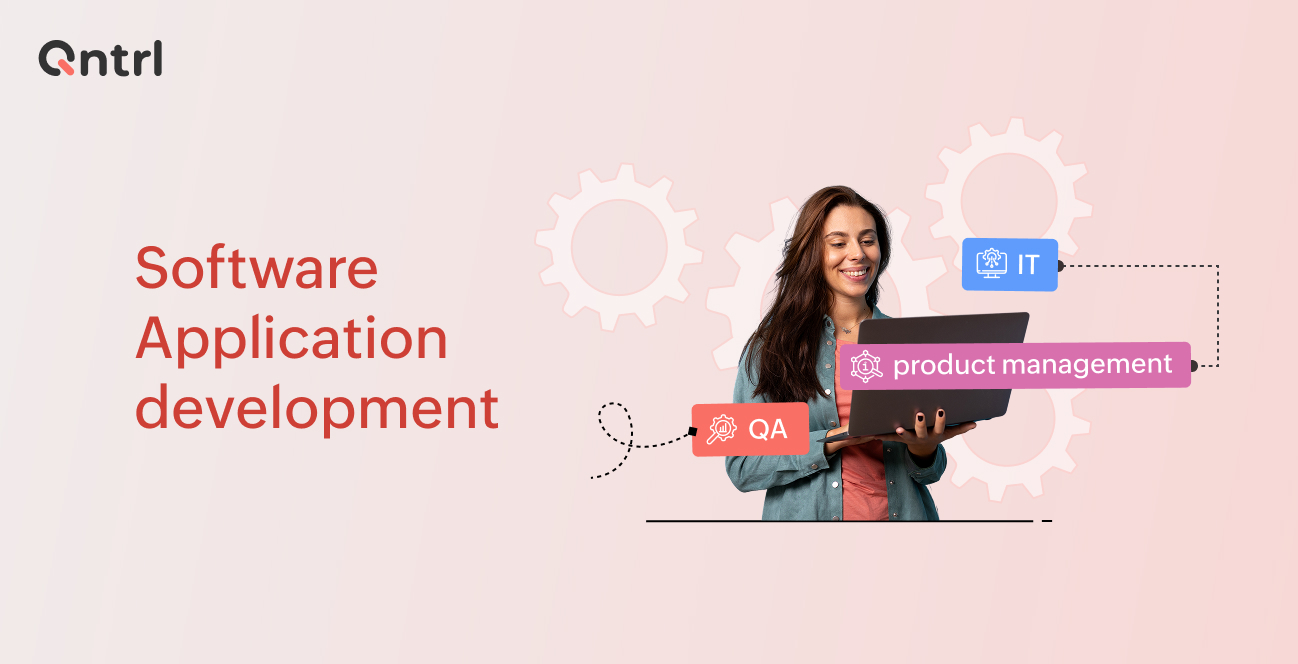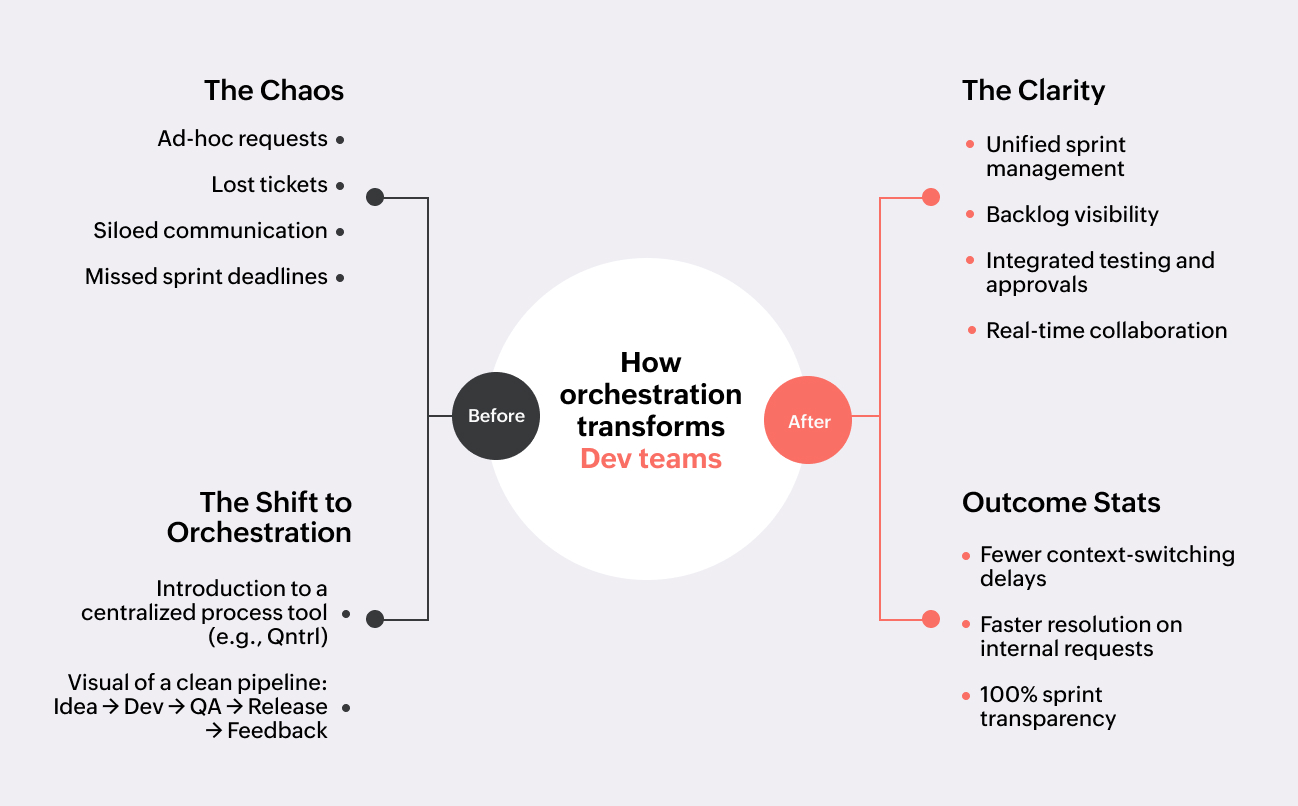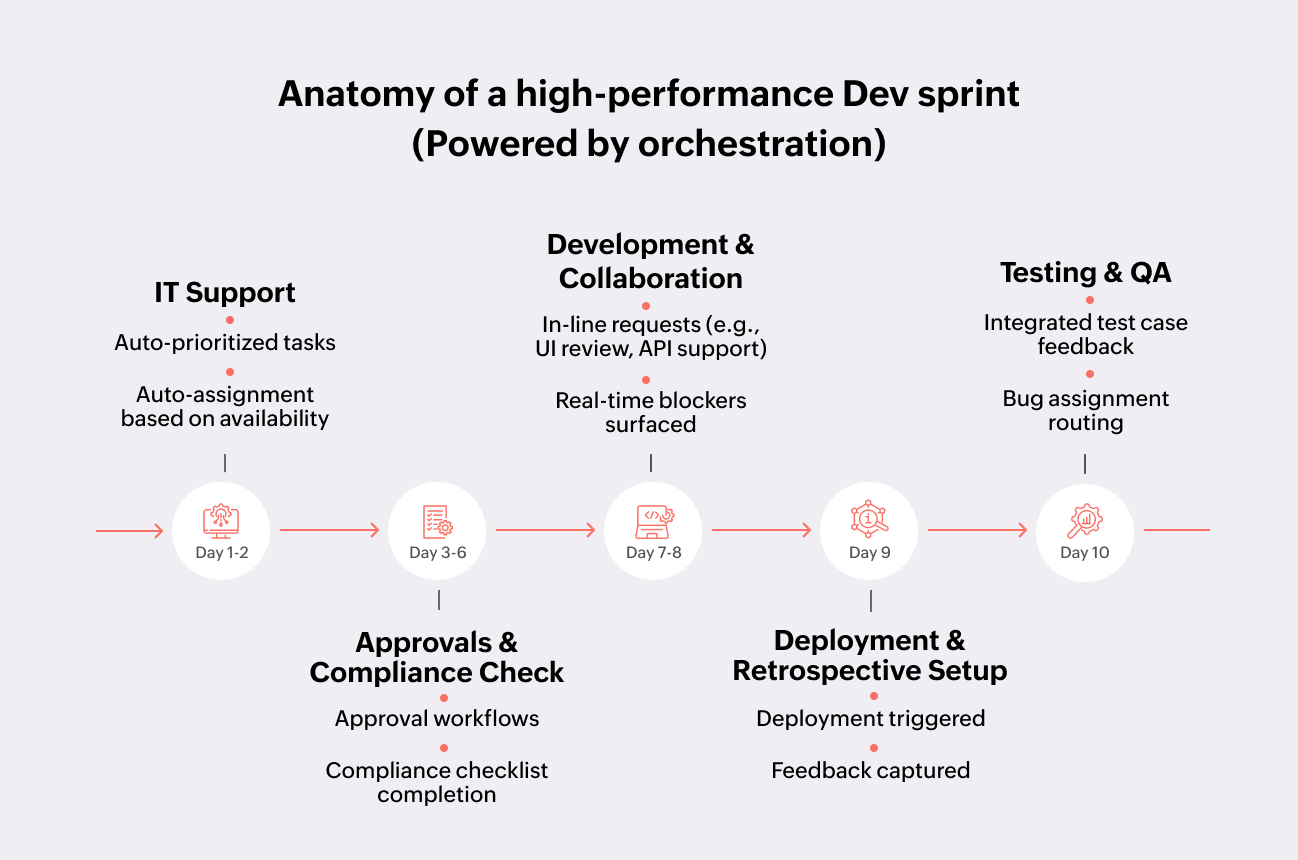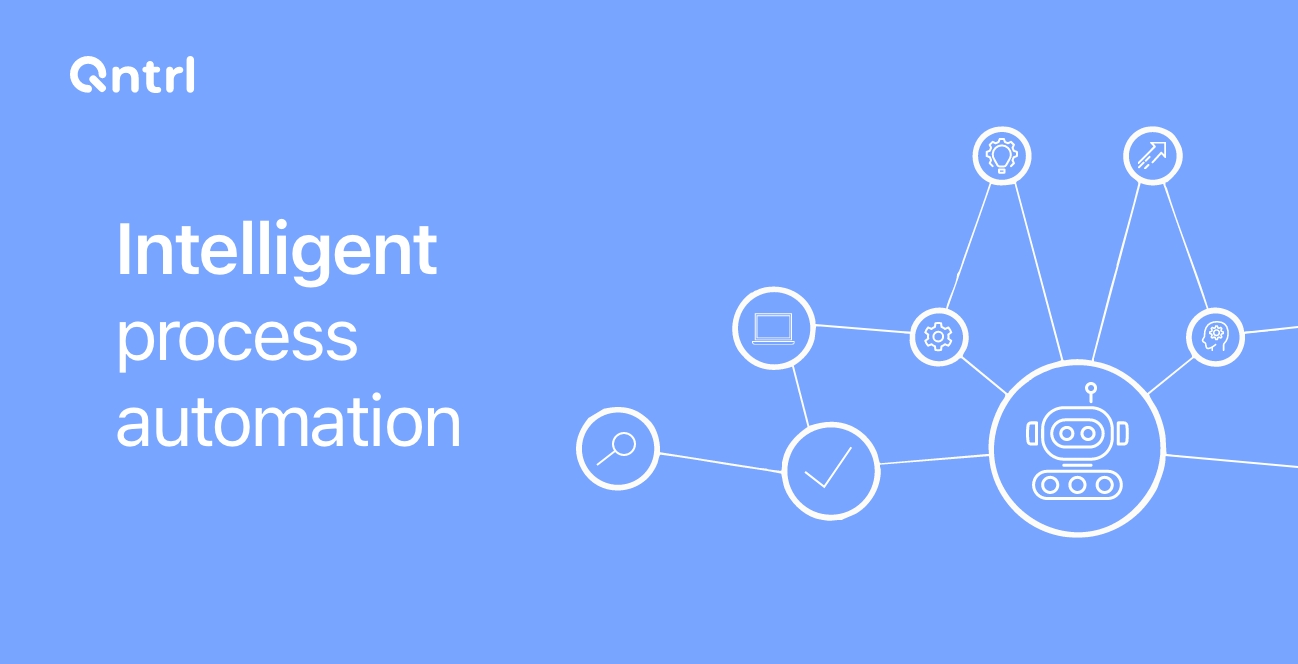Basics of modern software application development and how to orchestrate it

Software application development has undergone a massive shift over the past decade. What was once a function solely owned by IT and engineering teams has now become a collaborative, business-driven process. Organizations today demand software solutions that are faster to build, easier to modify, and better aligned to changing customer and market needs.
The competitive landscape of application development demands more than just writing good code. Teams require organized workflows which provide transparency and adaptability and accountability throughout all development lifecycle stages. The development process management methods have reached the same level of importance as the software itself because they span from ideation through deployment to continuous improvement.
To meet these new demands, companies are rethinking how they organize their development processes — moving away from ad hoc project management toward orchestrated, streamlined workflows that foster speed, collaboration, and compliance.
What software application development looks like today
Modern application development is no longer a siloed, sequential process handled only by software engineers. Instead, it is a dynamic, iterative cycle that integrates input and collaboration from product managers, QA teams, designers, compliance specialists, and even end users.
The modern software development process typically follows a series of stages.
- It begins with a simple idea, where new product features or improvements are gathered from various sources like the organization or customers.
- Next comes the feasibility evaluation, during which the viability of these ideas is assessed in terms of technical feasibility, resource requirements, cost, and potential business benefits.
- The development phase follows, where solutions are built in sprints or iterations, often using agile or hybrid approaches.
- Testing is then conducted to ensure that the application functions as expected while meeting security, compliance, and usability standards.
- Once testing is complete, the application or new features are deployed to production environments.
- Finally, the process includes gathering feedback from users and stakeholders, enabling continuous refinement and improvement of the application.
Every stage involves multiple stakeholders and requires fast, seamless collaboration. Speed to market, adaptability, and operational visibility have become just as critical as the coding itself.
key challenges holding back development teams
While the evolution of application development brings new opportunities, it also creates new operational challenges that can significantly slow down teams if left unaddressed:
- Communication silos: developers, testers, product managers, and leadership often operate in disconnected systems, leading to missed context, duplicated work, and misaligned expectations.
- Manual, inefficient processes: Approvals, task assignments, change requests, and feedback often occur over scattered emails, spreadsheets, or meetings, introducing bottlenecks and increasing human error.
- Lack of real-time visibility: without a centralized view of project status, stakeholders may not know what's blocked, what's delayed, or where resources are overstretched, resulting in scope creep and missed deadlines.
- Compliance and audit difficulties: As regulations tighten across industries, development teams need a reliable way to track changes, approvals, and test results. However, many teams lack integrated audit trails or standardized documentation workflows.
These challenges slow down development, increase risk, lower product quality, and hinder an organization's ability to adapt quickly to market demands.
The imperative of workflow orchestration in contemporary software development
Recently, traditional manual coordination methods have become increasingly redundant in a world characterized by rapid iteration, cross-functional collaboration, and complex system architectures.
Relying on disparate project management tools and communication channels often leads to inefficiencies, miscommunications, and delays.
Enter workflow orchestration: This approach automates and integrates various tasks, systems, and data flows, creating a cohesive and efficient development process.
Modern development is more intuitive than just task tracking—it demands orchestration. Teams face scattered requests, lost visibility, and constant deadline risks without it.
Orchestration introduces a unified flow that connects every stage, from idea to release, enabling real-time collaboration, backlog transparency, and faster resolutions. Here's a closer look at how orchestrating your workflows transforms development from chaos to clarity.
Key advantages of workflow orchestration
- Centralized pipeline management: Gain comprehensive visibility and control over the entire development lifecycle, from initial concept to deployment, ensuring all stages are aligned and transparent.
- Automation of repetitive tasks: Automate routine processes such as task assignments, approvals, and escalations, minimizing human error and freeing up valuable developer time.
- Enhanced real-time collaboration: Facilitate seamless communication among stakeholders across IT, business, and compliance domains, fostering a unified working environment.
- Accelerated delivery times: Orchestration expedites the development process by eliminating bottlenecks and ambiguities. It ensures that the right individuals are engaged at the appropriate stages, eliminating bottlenecks and ambiguities.
- Built-in compliance and audit trails: Automatically capture and document actions, approvals, and decisions, ensuring readiness for audits and adherence to regulatory standards.
Ultimately, workflow orchestration provides the operational framework necessary for development teams to move swiftly, adapt to changes, and deliver high-quality software without compromising on control or visibility.
Orchestration as the foundation for cross-team collaboration
Development, QA, IT support, and product management all play critical roles — and unless they're tightly connected, projects risk becoming chaotic and delayed. That's where orchestration platforms come in, acting as a central nervous system that keeps everything aligned and flowing smoothly.
On the development side, orchestration helps teams plan their sprints more effectively, keep their backlogs in shape, and manage code reviews without the last-minute scrambles. Instead of juggling tasks manually, everything gets routed and tracked in one place, making it much easier to maintain momentum.
Quality assurance also benefits massively. With orchestration, test triggers can be automated right when they're needed, bug tracking ties directly into development cycles, and feedback loops become faster and more actionable. It takes the friction out of finding and fixing issues before they become real problems.
IT support teams aren't left out, either. Orchestration ensures that environments are ready before they're needed, internal tools are supported without firefighting, and deployment workflows are cleanly mapped out — reducing those frustrating, "it works on my machine" moments.
And finally, product management gets a clear boost. With orchestration, prioritization stays on track with business goals, stakeholder feedback loops are built directly into the development process, and every feature or update can be traced back to the larger product roadmap. No more guessing where things stand or chasing updates across emails and meetings.
In short, orchestration binds all these moving parts together, helping teams move faster, collaborate better, and deliver higher-quality software with fewer headaches.

Integrating workflow orchestration across the software development lifecycle
Workflow orchestration is not confined to a single phase; it permeates every stage of the software development lifecycle, enhancing efficiency and coherence.
Idea intake and prioritization
Implement a structured system to capture and evaluate new ideas, feature requests, or project proposals. Automate the triage process based on predefined criteria such as business value, feasibility, and alignment with strategic goals.
Feasibility assessment and stakeholder engagement
Route proposals to relevant stakeholders—engineering leads, product managers, and finance teams—for timely evaluations. Set deadlines for assessments and automate reminders to ensure momentum is maintained.
Sprint planning and resource allocation
Dynamically assign developers, testers, and resources based on availability and expertise. Visualize workloads and timelines to balance capacity, preventing resource conflicts and ensuring optimal utilization.
Development and code review processes
Automate the creation of development tasks and establish multi-level code review workflows. Transparently track approvals and rework cycles, enabling parallel review processes to enhance throughput.
Testing and quality assurance
Automate the assignment of test cases, initiate regression testing post-code merges, and auto-assign bugs based on component ownership. Monitor bug resolution timelines with SLA-driven reminders and escalations to maintain quality standards.
Deployment and release management
Standardize deployment workflows with gated approvals and pre-launch checklists. Ensure all regulatory, security, and operational requirements are verified before production rollouts, mitigating risks associated with releases.
Continuous improvement and feedback integration
After deployment, trigger structured feedback collection from users and stakeholders. Route insights directly to product and engineering teams for rapid evaluation and prioritization in future development cycles, fostering a culture of continuous improvement.
By embedding orchestration into each phase, organizations can reduce delays, enhance predictability, and create a self-improving system that refines both applications and development processes over time.

The role of workflow orchestration platforms in accelerating development
Platforms designed for workflow orchestration offer structured, automated coordination across the development lifecycle, bringing several benefits to development teams:
- Customizable workflows: Tailor workflows to match your team's unique development processes, accommodating various methodologies and practices.
- Automated task management: Automate task assignments, deadlines, and SLA tracking, reducing manual intervention and ensuring timely completion.
- Real-time reporting and visibility: Provide stakeholders with up-to-date insights into project status, facilitating informed decision-making and proactive issue resolution.
- Role-based access control: Maintain governance and security by defining access levels based on roles, ensuring sensitive information is protected.
- Seamless integration with existing tools: Integrate with tools like Git, Jira, Slack, Cliq and others to ensure a cohesive development environment without disrupting existing workflows.
- Audit-ready documentation: Generate detailed logs of actions, approvals, and decisions, simplifying compliance reporting and retrospective analyses.
Implementing such platforms enables development teams to streamline processes, enhance collaboration, and maintain control over complex workflows.
Streamlining development through workflow management
- Managing feature requests from intake to production without backlog chaos: Workflow management tools can help you streamline the entire process, ensuring that each feature request is properly documented, assigned, and tracked through every stage of development. This reduces the chance of backlog bottlenecks and ensures timely delivery.
- Coordinating faster deployments across development, QA, and release management teams: Customizable workflows ensure that all teams are aligned, reducing handoff times and minimizing errors during each stage of development, testing, and deployment. With automated approvals and task assignments, teams can quickly move from one stage to the next, speeding up the entire deployment cycle.
- Automating compliance documentation alongside ongoing development to avoid last-minute scrambles: Compliance tasks often fall by the wayside during development cycles. With a workflow orchestration tool, you can automate the generation and management of compliance documentation, ensuring that all necessary approvals and checks are carried out without disrupting the development process. This reduces the stress of last-minute compliance audits.
How a workflow orchestration platform accelerates development
Platforms built for workflow orchestration bring structure, speed, and control to the entire application development process. They create a structured environment for managing complex workflows across your teams. This eliminates manual task management, provides visibility across the project lifecycle, and empowers teams to meet deadlines with precision.
Why investing in orchestration future-proofs your development operations
- Scalable processes that grow as your teams and project portfolios expand: As your organization scales, so do your workflows. With Qntrl, you can create workflows that evolve as your team grows and handles more projects. The platform adapts to the increasing complexity of your operations, allowing you to maintain high performance without adding unnecessary overhead.
- Empowering non-technical stakeholders to participate meaningfully without slowing down developers: One key benefit of Qntrl is that it empowers non-technical stakeholders, such as project managers and business analysts, to engage with the development process without needing deep technical knowledge. This improves cross-functional collaboration while keeping developers focused on coding.
- Flexibility to adapt workflows as technologies and business needs evolve: In a fast-paced industry, adaptability is crucial. Qntrl allows you to adjust workflows as your technology stack or business needs change, ensuring your team can continue innovating and delivering solutions that meet market demands.
Better applications are built with better workflows
- Delivering great software today requires more than writing good code—it requires managing development with speed, transparency, and control. The best software isn't just the result of writing great code; it's also about managing the process efficiently. Workflow orchestration ensures that teams collaborate effectively, meet deadlines, and address any blockers swiftly.
- Workflow orchestration platforms empower teams to move faster, collaborate better, and innovate continuously. By providing teams with the tools they need to orchestrate their workflows efficiently, workflow orchestration tools foster a culture of speed, innovation, and collaboration. The result? Faster product iterations, better software quality, and a more responsive development environment.
Ready to streamline your development workflows?
See how Qntrl can help your teams build smarter, launch faster, and stay in control.
Enjoying your reading?
Enjoy organization and visibility too!
Qntrl can help you organise, control and improve production and projects in your team.







